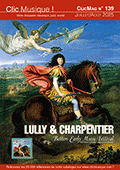 Le chœur suisse de l’Ursenkathedral Solothurn est composé d’enfants et de jeunes adultes tous de bleu vêtus. Il se consacre habituellement au répertoire sacré tout en s’émancipant parfois vers des territoires plus contemporains en témoigne le programme hétérogène de ce disque portrait. Passée l’inspiration haïtienne de la pièce "Tchaka", pittoresque sans être déterminante, du compositeur Sydney Guillaume qui donne son titre à l’album, le Kyrie du letton Ugis Praulins offre la prestation inouïe d’un petit chanteur aux aigus transcendants (Silas Aechlimann) rappelant le "Miserere" d’Allegri. Si les deux opus de Mendelssohn (op. 39 et 69) sont suffisamment calibrés, le "Os Justi" de Bruckner manque de chair et de densité. Les attaques des pupitres sont parfois imprécises, la dynamique de l’ensemble en pâtit et les solistes enfants sont inégaux. Le "Cantique de Jean Racine" de Fauré jouit d’un pastoralisme sulpicien. Entre le paisible "Loch Lomond" revu par Jonathan Quick (né en 1970), le "Pseudo Yoik" qui évoque le chant eskimo traditionnel (Jaakko Mantyjarvi), l’incantatoire et cyclique "Incantatio maris aestuosi" de Veljo Tormis, deux compositions d’après des airs populaires du chef de l’ensemble Tobias Stückelberger se glissent quelques musiciens locaux à travers de brèves pièces chorales idiomatiques (Eugen Meier, Paul Miche). On termine en beauté avec le "Gesang der Geister über den Wassern" D 704 de Schubert qui connaît ici une version accompagnée d’un quatuor à cordes d’une troublante neutralité. Bienvenue donc au Singknaben! (Jérôme Angouillant)  ‘Tchaka‘ - that's a traditional stew from Haiti, and just like in a good stew, the Singknaben der St. Ursenkathedrale Solothurn, under the direction of Tobias Stückelberger, present a diverse mixture of the most varied musical influences and cultures on their new album. With a tradition dating back over 1200 years, the Singknaben are considered the oldest boys' choir in Switzerland. Starting from their church tradition, the album begins with romantic motets and psalm settings by Ugis Praulinš, Felix Mendelssohn Bartholdy and Anton Bruckner, and leads through some choral favourites such as Gabriel Fauré's ‘Cantique de Jean Racine’ to arrangements of Swiss folk songs and works from the Solothurn region such as the ‘Heimetvogel’ (Bird of Home) and the men's choir work ‘Terre Jurassienne’. The programme continues northwards with contemporary works from Estonia (Veljo Tormis) and Finland (Jaakko Mäntyjärvi and Mia Makaroff). In the arrangement of ‘The Code’ by Nemo - as in the album itself - a wide variety of musical styles come together. The album closes with farewell songs that are not always peaceful, including Franz Schubert's ‘Gesang der Geister über den Wassern’, set to monumental music by the male voices and low strings. The album impresses with its clever selection of works, which, despite their diversity, form a large thematic framework, and especially with the specially written arrangements, recorded for the first time, with which the choirboys themselves contribute a piece to the choral tradition.
 |
